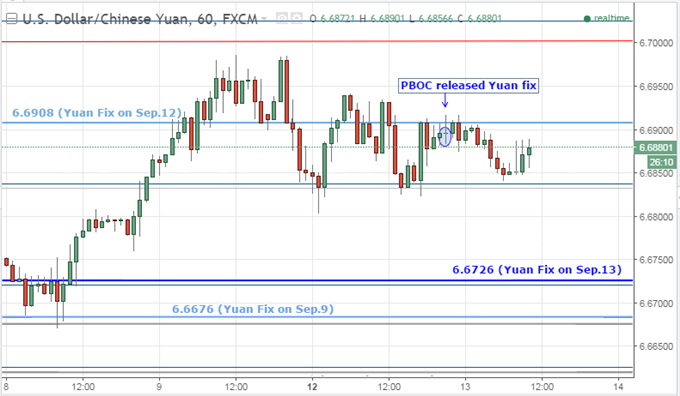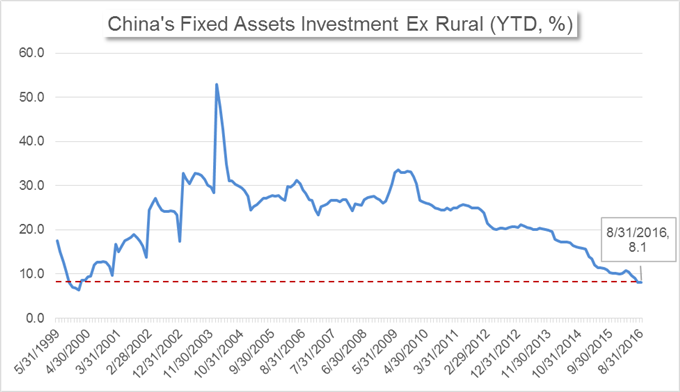This daily digest focuses on Yuan rates, major Chinese economic data, market sentiment, new developments in China’s foreign exchange policies, changes in financial market regulations, as well as market news typically available only in Chinese-language sources.
- The offshore USD/CNH retraces within a range despite of a stronger fix set by the PBOC.
- China’s total investment and private investment continued to grow at the slowest pace on record.
- The central government’s business tax income in the first seven months came in at 30 times more than planned.
To receive reports from this analyst, sign up for Renee Mu’ distribution list.
Yuan Rates
- The PBOC guided the Yuan higher by +182 pips or +0.27% against the U.S. Dollar to 6.6726 on September 13th. We can see from the 1-hour chat that a Doji candle formed following the release of the Yuan fix. This indicates indecision from traders despite of the Central Bank’s guidance. The PBOC appears to want to keep the Dollar/Yuan below the psychological level of 6.70. At the same time, the US Dollar has been extremely volatile since last Friday’s comments from Boston Fed President Rosengren who is also a FOMC voting member. With mixed moves from the two central banks, the USD/CNH is retracing within a range between 6.6832 and 6.6982.
USD/CNH 1-Hour

Created with Marketscope/Trading Station II; prepared by Renee Mu.
Key Economic Data
- Chinese investment in fixed assets shows continued slow growth in August. The national-wide fixed assets investment excluding rural households grew 8.1% in January-August on an annualized basis. In specific, private investment in fixed assets rose 2.1% over the same span of time. Both growth rates remained unchanged from the month prior; however, both have been the lowest rates of all-time.
China’s national statistics bureau reports cumulative growth rates (year-to-date) for fixed assets gauges, such as January-August, rather than individual values for a month, such as August.
The private investment in fixed assets hit the lowest level since March 2012 when the index was quoted. The decline in the growth rate of private investment has also accelerated since Mid-2015: the gap between the growth in private investment and the growth in total investment (fixed assets investment ex rural) started to widen. This means that not only does investment in China continue to slow down in general, private-owned companies that used to be key drivers to the economy show even less incentive to expand their business.

Data downloaded from Bloomberg; chart prepared by Renee Mu.
Take a look at a longer time frame: the growth rate of the total investment has dropped to the lowest level since 1999.

Data downloaded from Bloomberg; chart prepared by Renee Mu.
As we discussed earlier, the slow growth was mainly led by lacking investment opportunities rather than shortage in funds. Therefore, additional easing measures from the Central Bank may not help much; it will be more useful to provide investment opportunities to private sectors. That is why the Chinese government have been promoting the Public-Private-Partnership (PPP) model and encouraging private firms to participate in projects announced at the 13th Fifth plenum.
Market News
Sina News: China’s most important online media source, similar to CNN in the US. They also own a Chinese version of Twitter, called Weibo, with around 200 million active usersmonthly.
- China’s actual business tax income of the central government in January to July came in at 3049.5% of the business tax planned, according to the Finance Ministry. The ratio of actual-income-to-planed-income of the central government in most categories falls below 100% in January to July, meaning the actual income collected is less than planned. However, the actual business tax collected turns to be 30 times more of the planed business tax, following the landmark tax reform introduced on May 1. The replacement of value-added tax to business tax is supposed to reduce the tax burden on companies, especially in a slowing economy. In terms of the incredibly high rise in business tax, the Finance Ministry explained that the unusual print was led by the inclusion of 50% of business tax into the central government’s income, which was used to categorize as sole local governments’ income.
-To receive reports from this analyst, sign up for Renee Mu’ distribution list.






